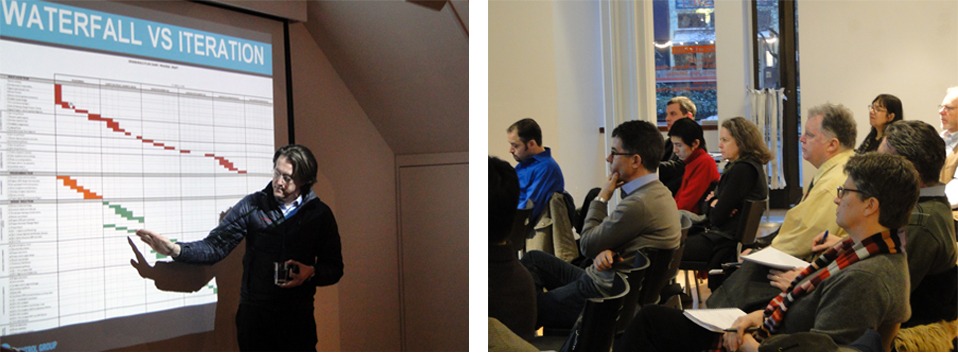by: Matt Shoor AIA LEED AP
It has always been critical for architects to stay abreast of technological advancements. In past eras, technological changes impacted building systems or typologies, both of which were still reliant upon the laws of physics. The profession could comprehend the ramifications of these changes quite easily, since they merely modified the literal building blocks of edifices. Today, architects have, of course, incorporated digital technology in their practices. But as a means to an end: the physicality of a building. In a rapidly digitizing world, where lightning-fast advancements take no physical form, what is an architect to do?
The series, “Leading Architecture in a Changing World,” intends to address this and many other questions engendered by the business climate anecdotally referred to as the “New Normal.” The second speaker in the series, Campbell Hyers of Control Group, identified constructed spaces where digital strategy, deployed by commercial enterprise, directly impacted the built environment. (The next installment, Critical Issues in Talent Planning and Strategic Human Resources, is this Monday, 04.08.13.)
Initially, Hyers highlighted many of the foundational principles underpinning the work of digital companies. Some of these notions, such as the iteration and testing of ideas, would be familiar to most designers. The introduction of doubt in the design process was one of Hyers’ most novel ideas discussed. When Control Group starts a project, they may have a very hazy idea of what digital platforms they will ultimately produce for the client.
Architects, while experts at the iterative process of design and accustomed to a demarcated set of deliverables at each stage of design, could glean much from this technique. If nothing else, the employment of doubt in the design process might help to manage client expectations, and could result in more creative explorations that yield satisfying, tangible results.
Hyers also pointed out that digital strategy in the built world is much more than simply specifying flat-screen televisions in conference rooms. In fact, since all of our devices (mobile phones, televisions, computers, tablets, etc.) are somewhat fungible, digital strategy ideally piggybacks on existing behaviors and can morph to accommodate technological advances in display media.
An exemplary project was Control Group’s food service rollout at LaGuardia Airport, commissioned by OTG Management in partnership with Delta Airlines. The goal was to revolutionize the experience of dining while waiting for a flight. To do so, Control Group dispensed with restaurant-specific dining areas, consolidating them into a series of smaller spaces. Each of the seats in the new arrangement has a dedicated tablet attached to the tabletop. These devices allow the user to search the Internet, check flight status, and, most crucially, purchase a meal from any of the restaurants in the terminal. The food would be delivered to that seat within a matter of minutes. This simple platform reduces service time, creates a more relaxed user experience, decreases meal cost while increasing quality and eliminating queues. The revenue boost was immediate.
In other words, the design and specification process was driven by both doubts about what was really needed to execute the client’s needs, and a desire to innovate without prior suppositions about the digital technology that would elevate the project to the next level of retail and restaurant space.
Beyond case studies, Hyers presented compelling motivation for architects to embrace digital strategies. Designers, as members of the professional service class, must meet the expectations of modern consumers, who clearly desire technological integration in their homes, offices, and places of commerce. Architects should do as much as they can to incorporate digital strategies in the design of these spaces. To do otherwise risks the design of a building with a 20th-century-user experience.
Matt Shoor is an architect, writer, and educator currently employed by Macrae-Gibson Architects. He is a frequent contributor to e-Oculus, and can be reached at mshoor@gmail.com.
Event: Leading Architecture in a Changing World: Digital Strategies for Architects and Our Clients
Location: Center for Architecture, 03.18.13
Speaker: Campbell Hyers, CEO, Control Group
Organizers: AIANY Chapter Professional Practice Committee and AIANY staff









